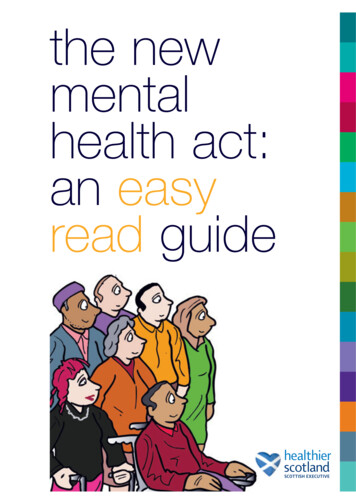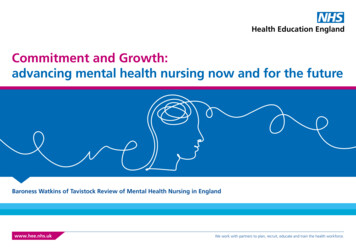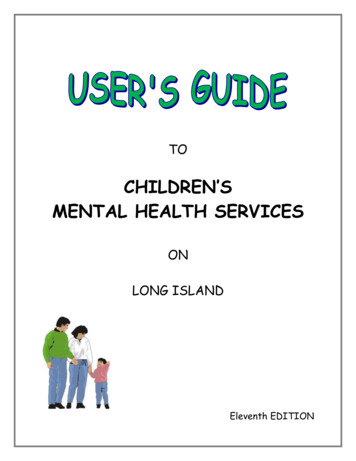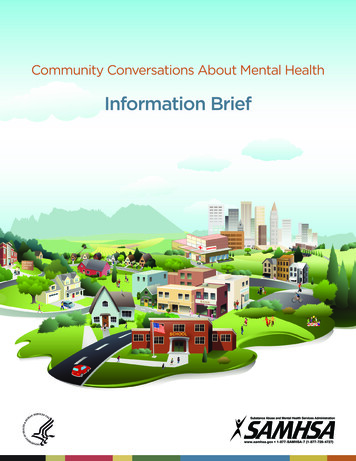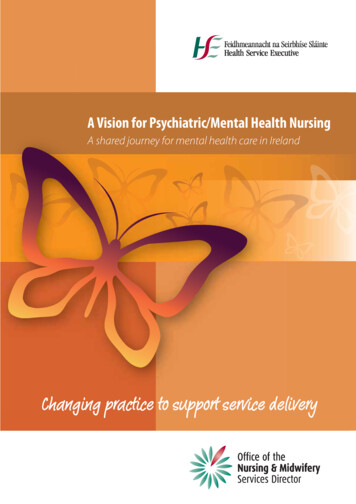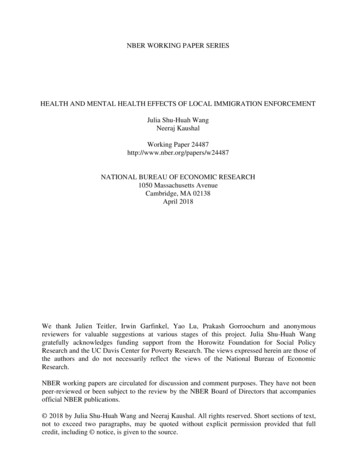
Transcription
NBER WORKING PAPER SERIESHEALTH AND MENTAL HEALTH EFFECTS OF LOCAL IMMIGRATION ENFORCEMENTJulia Shu-Huah WangNeeraj KaushalWorking Paper 24487http://www.nber.org/papers/w24487NATIONAL BUREAU OF ECONOMIC RESEARCH1050 Massachusetts AvenueCambridge, MA 02138April 2018We thank Julien Teitler, Irwin Garfinkel, Yao Lu, Prakash Gorroochurn and anonymousreviewers for valuable suggestions at various stages of this project. Julia Shu-Huah Wanggratefully acknowledges funding support from the Horowitz Foundation for Social PolicyResearch and the UC Davis Center for Poverty Research. The views expressed herein are those ofthe authors and do not necessarily reflect the views of the National Bureau of EconomicResearch.NBER working papers are circulated for discussion and comment purposes. They have not beenpeer-reviewed or been subject to the review by the NBER Board of Directors that accompaniesofficial NBER publications. 2018 by Julia Shu-Huah Wang and Neeraj Kaushal. All rights reserved. Short sections of text,not to exceed two paragraphs, may be quoted without explicit permission provided that fullcredit, including notice, is given to the source.
Health and Mental Health Effects of Local Immigration EnforcementJulia Shu-Huah Wang and Neeraj KaushalNBER Working Paper No. 24487April 2018JEL No. I1,I14,I3,J15,J18ABSTRACTWe study the effect of two local immigration enforcement policies – Section 287(g) of the IllegalImmigration Reform and Immigrant Responsibility Act and the Secure Communities Program(SC) – that have escalated fear and risk of deportation among the undocumented on the healthand mental health outcomes of Latino immigrants living in the United States. We use therestricted-use National Health Interview Survey for 2000-2012 and adopt a difference-indifference research design. Estimates suggest that SC increased the proportion of Latinoimmigrants with mental health distress by 2.2 percentage points (14.7 percent); Task ForceEnforcement under Section 287(g) worsened their mental health distress scores by 15 percent(0.08 standard deviation); Jail Enforcement under Section 287(g) increased the proportion ofLatino immigrants reporting fair or poor health by 1 percentage point (11.1 percent) and loweredthe proportion reporting very good or excellent health by 4.8 to 7.0 percentage points (7.8 to 10.9percent). These findings are robust across various sensitivity checks.Julia Shu-Huah WangThe University of Hong KongHong Kongjshwang@hku.hkNeeraj KaushalColumbia UniversitySchool of Social Work1255 Amsterdam AvenueNew York, NY 10027and NBERnk464@columbia.edu
Health and Mental Health Effects of Local Immigration EnforcementINTRODUCTIONOver the past decade, the terrain of immigration enforcement in the United States hasexpanded from national borders to local and state jurisdictions, resulting in an increasing numberof arrests on grounds of immigration status and national origin (Lacayo, 2010). 1 Involvement oflocal and state governments in immigration enforcement intensifies fears of deportation and islikely to cause stress and adversely impact the physical and mental health of undocumentedimmigrants and their family members, many of whom may be U.S. citizens. 2 Local enforcementis also likely to make undocumented immigrants and their families more vulnerable to workplaceexploitation, reduce their social interactions and use of essential public services, and generallyincrease mistrust towards public institutions, in particular local law enforcement agencies(Gleeson, 2014; Hacker et al., 2011; Hardy et al., 2011; Rhodes et al., 2015).Previous research documents that local and state government participation in immigrationenforcement has affected immigrant settlement patterns, employment, and earnings, and patternsof farm labor use and farm profitability (Pham & Van, 2010; Capps, Rosenblum, Rodriquez, &Chishti. 2011; Kostandini, Mykerezi, & Escalante, 2013; Watson, 2013). Local or state-specificstudies using qualitative approaches also suggest that local enforcement increased stress andanxiety among immigrants and deterred them from seeking health services (Rhodes et al., 2015;1During 2006-2012, local officials deputized under 287(g) arrested 256,330 undocumented immigrants (ICE FOIA,2015). In 2008, the number of removals under 287(g) represented 9.5% of all ICE immigrant removals, with a noninsignificant number being removed based on minor traffic offenses such as driving without license or driving underthe influence (Lacayo, 2010; Vaughan & Edwards, 2009).2In the 2008 National Survey of Latinos administered by Pew Hispanic Center, nearly 10% of Hispanic adults (bothnative-born and immigrants) reported being asked by the police or other authorities about their immigration status inthe past year, and 35% of native-born Hispanic citizens said that they worried “a lot or some” about deportation ofrelatives, or friends (Lopez & Minushikin, 2008). Lacayo (2010) cites anecdotal evidence of Latinos being subject toracial profiling and were increasingly pulled over and interrogated for minor offenses as an excuse to check theirdocumentation status.2
Hacker et al., 2011). There is, however, little systematic national research on health and mentalhealth effects of local immigration enforcement, resulting in a critical knowledge gap on the fullrange of impacts of what has become a salient feature of the U.S. government’s approach toundocumented immigration and is being vigorously pursued by the Trump administration.In this paper, we bridge this knowledge gap by investigating the effects of two localenforcement policy initiatives: Section 287(g) of the Illegal Immigration Reform and ImmigrantResponsibility Act (IIRIRA) and the Secure Communities program (SC). Section 287(g) gavelocal jurisdictions the option to participate in immigration enforcement with two types ofagreements: Task Force Enforcement (TF) allowed state and local law enforcement to screen forimmigration status during regular policing operations (street screening) and Jail Enforcement(JE) allowed screening for immigration status in jails. The Secure Communities programrequired matching fingerprinting of all arrested individuals with the Immigration and CustomsEnforcement (ICE) database to screen for immigration violations. We take advantage of thegeographic (county-level) and temporal variations in the implementation of these policies. Theempirical analysis is based on the restricted-use National Health Interview Survey (NHIS) (20002012) that provides information on health and mental health conditions as well as county- andstate-level identifiers to match policy variables to the individual-level health and demographicdata.We adopt a difference-in-difference research design to control for unobserved timevarying factors correlated with county/state level enforcement policies. This methodologyrequires selection of treatment and comparison groups. The treatment group of our analyses is:foreign-born Latino adults living in families with at least one non-citizen family member. Due tothe high probability of the presence of undocumented persons in these families, this group is3
likely to be highly vulnerable to local enforcement policies. We also experiment with a narrowertreatment group that has an even heightened risk of having undocumented family members andtherefore higher vulnerability to local enforcement: non-citizen Latino adults living in familieswith only non-citizen family members. The comparison group of the analysis is U.S. born nonHispanic white adults, whose members are unlikely to be affected by enforcement policies. Theunderlying assumption of the difference-in-difference design is that time-varying unobservedfactors correlated with state/county enforcement policies have the same effect on the two groups.We obtain the difference-in-difference estimates by deducting the changes in outcomes for thecomparison group before and after policy implementation, that capture the effect of unobservedtime-varying factors, from the corresponding changes in outcomes for the treatment group.Additionally, our analyses control for a rich set of economic and policy variables, discussed indetail below, whose effects are allowed to be different across the treatment and comparisongroups.We find that the Secure Communities Program increased mental health distress amongLatino immigrants living with non-citizen family members by 2.2 percentage points (14.7percent), and Task Force Enforcement agreements under Section 287(g) deteriorated their mentalhealth distress scores by 15 percent (or 0.08 standard deviation); Jail Enforcement under Section287(g) increased the proportion of Latino immigrants reporting fair or poor health by 1percentage point (11.1 percent) and lowered the proportion reporting very good or excellenthealth by 4.8 to 7.0 percentage points (7.8 to 10.9 percent). These findings remain robust acrossvarious sensitivity checks.LOCAL IMMIGRATION ENFORCEMENT POLICIES – SECTION 287(G) ANDSECURE COMMUNITIES4
In 1996, with the ostensible goal to improve public safety and remove illegal immigrantswho committed serious offenses, the Illegal Immigration Reform and Immigrant ResponsibilityAct, Section 287(g) granted state and local jurisdictions the option to participate in enforcingfederal immigration laws. Localities opting to participate signed a Memorandum ofUnderstanding with ICE that required establishing a supervisory structure to support localitiesand train local officials to enforce immigration laws. Local participation in Section 287(g) wasnegligible in the first decade after its passage. In 2002, Florida Department of Law Enforcementand in 2003 Alabama Department of Public Safety were the first two localities to sign 287(g)agreements with ICE. Local participation in 287(g) slowly picked up in 2005 and peaked in2009, when the number of localities participating in the program rose to 76. Twenty-fourjurisdictions signed Task Force Enforcement (TF) agreements, 47 signed Jail Enforcement (JE)agreements, and 5 signed both TF and JE. Overall, TF agreements covered 22% (690 out of 3140counties) of the counties nationally, and JE agreements cover 3% (106 counties) of all counties(Figure 1).Interior immigration enforcement took another turn in 2008 with the launch of the SecureCommunities Program (SC) that required the local police to match fingerprints of all arrestedindividuals with the ICE database to screen for immigration violations. Whereas Section 287(g)was designed to engage local law enforcement in immigration enforcement, Secure Communitiesallowed ICE a remote presence in local law enforcement agencies. Under SC, the state and localauthorities were required to submit fingerprints of all arrested individuals to the Federal Bureauof Investigation (FBI), which the latter shared with ICE to check against immigration databasesto identify (removable) undocumented individuals (ICE, 2015). Unlike Section 287(g),participation in Secure Communities was not voluntary. It was gradually rolled out across5
counties: beginning with 14 counties in 2008 to all counties nation-wide in 2013 (Figure 1). 3 Inresponse to public concerns about racial profiling, in 2012, TF was discontinued and in 2015, SCwas replaced by the Priority Enforcement Program (PEP) that focuses on immigrants involved inorganized criminal gangs or those that pose a danger to national security (ICE, 2016).Previous research suggests that stricter local immigration controls reduced the economicopportunities of immigrants, lowering their employment, wages, and remittances (Kostandini,Mykerezi, & Escalante, 2013; Pham & Van, 2010; Gentsch & Massey, 2011; Amuedo-Dorantes& Puttitanun, 2013). The implementation of Section 287(g) was also associated with a decreasein claims against employers’ discrimination based on national origin, indicating that enforcementpolicies had a “chilling effect” on vulnerable immigrants (Gleeson, 2014). Studies suggest thatenforcement policies had a mixed impact on crime: Koper et al. (2013) found no effect in PrinceWilliam County, Virginia, whereas Donato & Rodriquez (2014) reported a higher rate of policearrests on grounds of immigration status and national origin in Davidson County, Tennessee.Evidence is also mixed on the effect of local enforcement on migration patterns: Watson (2013)found that Task Force Enforcement policies increased the outflow of non-citizens with somecollege education, Ellis, Wright and Townley (2016) found that hostile immigration policies (e.g.,local immigration enforcement policies, E-Verify, access to driver’s licenses) in a state reducedthe inflow of non-citizen and naturalized Latinos in that state, whereas Parrado (2012) found that287(g) did not affect the size of Mexican immigrant population in most localities except for largecities such as Dallas, Los Angeles, Riverside, and Phoenix, which registered a decline in thenumber of Mexican immigrants relative to other large cities without 287(g). In addition, research3Some localities resisted the implementation of SC (Chen, 2016; Strunk & Leitner, 2013), but such initiatives werenot systematically and reliably documented for a national-level examination of their impacts. To the extent that suchintentions are a permanent (time-invariant) feature of a locality (e.g., if a locality has a strong long term pro- or antiimmigrant environment), county fixed effects included in our analysis will control for it.6
suggests that local immigration enforcement increased Latino housing foreclosure rates (Rugh &Hall, 2016) and food insecurity and poverty in vulnerable families with children (AmuedoDorantes, Arenas-Arroyo & Sevilla, 2016, Potochnick, Chen, & Perreira, 2016; Rugh & Hall,2016).IMMIGRATION ENFORCEMENT AND HEALTHImmigration is a stressful undertaking with negative psychosocial impacts (Vega &Amaro, 1994; Jasso et al., 2004). It is associated with increased stress, fear, and uncertainty. Forfamilies with undocumented members, the negative health effects of migration are more intenseand complicated (Sullivan & Rehm, 2005; Delva et al., 2013). Repeated exposure to prejudice,discrimination, and exploitation on account of immigration status, and concerns about disclosureand deportation, of oneself or a family member, are likely to leave a negative impact on thephysical as well as mental health of the undocumented and their family members (Vega &Amaro, 1994; Cavazor-Rehg et al., 2007; Sullivan & Rehm, 2005).Immigration enforcement policies may affect health status of undocumented immigrantsand their families in several ways. First, enforcement policies increase the risk of deportation andwill likely to increase stress, fear, and anxiety among undocumented immigrants and their familymembers, which may adversely affect their health. Second, increased risk of deportation is likelyto reduce economic opportunities of the undocumented and increase risk of workplaceexploitation, which could in turn have negative health and mental health effects. Third, tominimize risk of deportation, the undocumented may reduce their time driving on the road,which may result in isolation and reduced social interaction and health service utilization(Rhodes et al., 2015; Hardy et al., 2011). Fourth, local enforcement may escalate immigrants’levels of mistrust toward public institutions, further lowering their health and social service7
utilization (Watson, 2014; Padraza & Zhu, 2015; Rhodes et al., 2015; Cavazos-Rehg, Zayas &Spitznagel, 2007). Finally, to cope with the escalated psychological and economic burdenassociated with the increased risk and exploitation, immigrants may adopt certain unhealthybehaviors (e.g. smoking, alcohol consumption) leading to health deterioration. 4Most prior studies investigating the effects of local enforcement on health and mentalhealth of immigrants were at a state- or local-level. Rhodes and colleagues (2015) study theimpact of Section 287(g) on Hispanic immigrants in local counties in North Carolina; Hacker etal. (2011) study impacts of ICE activities in Everett, Massachusetts; Hardy et al. (2011) study theimpact of the SB 1070 in Arizona, a bill that made failure to possess immigration documents acrime and expanded police power to detain potentially undocumented residents; and Lopez et al.(2016) study the impact of an immigration raid in the Washtenaw County, Michigan. The firstthree papers have used qualitative interviews and focus groups to study the effect of localenforcement. 5 Respondents in these studies stated that they avoid using health care and othersocial services because of the threat of police enforcement while driving and their lack of trust inpublic institutions. They also reported delays in preventive services, incomplete sequence of care,reduced utilization of preventive and curative care, increased use of nonstandard and unsafecontingencies for care, and deterioration in mental health among family members.Previous studies on the relationships between immigration enforcement and health didnot specifically study the impact of 287(g) or Secure Communities policies. Lopez andcolleagues (2016) used survey data collected before (n 325) and after (n 151) an immigration4These mechanisms closely mirror the framework through which Philbin and colleagues (2017) conceptualize howimmigration-related policies may influence the health among Latinos.5Rhodes and colleagues (2015) also used vital records data to quantitatively examine impacts of 287(g) on twomeasures of prenatal care: late entry into care and inadequate care. They found that 287(g) delayed Hispanic/Latinamothers to seek prenatal care and increased their likelihood to receive inadequate care compared to nonHispanic/Latina mothers. However, health and mental health impacts of 287(g) were only examined qualitativelythrough interviews and focus groups.8
raid and found that completing the survey after the raid was associated with lower self-ratedhealth and higher stress. Hatzenbuehler et al. (2017) used 14 policies in the domains ofimmigration, race/ethnicity, language, and agricultural worker protections to create a policyclimate index and used the Behavioral Risk Factor Surveillance System for 2012 to examine theassociation between the policy climate and immigrant mental health. Their research suggests thatstates that scored higher on the policy climate index, signifying a more exclusionary policyenvironment, were associated with poor mental health days in the past month among adults, andsuch association was stronger for Latinos. But this study is based on one year of data, because ofwhich it is difficult to distinguish the effect of enforcement policies from those of unobservedstate and county factors.There is no national level study of the effect of local immigration enforcement on healthand mental health of the undocumented and their family members. Ours is the first study to usenational data. Secondly, studies on the relationships between immigration enforcement andhealth have mostly treated enforcement as a cluster of policies. We study the impact of specificdimensions of enforcement, namely: Task Force enforcement under 287(g), Jail Enforcementunder 287 (g) and Secure Communities program. Finally, none of the existing studies usedrigorous econometric models to identify the causal effects of local immigration enforcement onhealth and mental health of Latino immigrants, as we do in our paper.This research is critical as negative health and mental health in immigrant communitieshas economic and fiscal consequences, including increased public health expenditures andreduced labor productivity (Brown et al., 2002; Martin et al., 2008; DeSalvo et al., 2009;Pirraglia et al., 2011; Bernard, Farr, & Fang, 2011). Heightened health care costs along with theburden of poor health would adversely affect the wellbeing of immigrants in low-income9
neighborhoods and slow down their integration with the mainstream society. In this study, wetake advantage of the “natural experiments” created by variations in the implementation of localimmigration enforcement under Section 287(g) and Secure Community initiative acrossgeographic locations (state and local jurisdictions) and time to study their effects on the healthand mental health of the undocumented and their families.RESEARCH DESIGNOur objective is to study health impacts of local immigration enforcement on not only theundocumented immigrants, who are directly affected by local immigration enforcement, but alsotheir family members who may be legal immigrants or U.S. citizens. The analysis is conductedon two samples of adults aged 18 to 60, born in Latin America (Latino immigrants hereafter):those in households with at least one non-citizen member (treat 1) and those in households withonly non-citizen family members (and no citizens in the family; treat 2). We focus on thesegroups because 77 percent of all undocumented immigrants in the U.S. come from LatinAmerica, with Mexico being the largest country of origin (56% of all undocumented immigrants),followed by Guatemala (6%), El Salvador (4%), and Honduras (3%) (Passel & Cohn, 2011;Zong & Batalova, 2016). Estimates show that 47% of foreign-born Latinos or 68% of non-citizenLatinos in the U.S. were undocumented in 2012 (U.S. Census Bureau, 2012; Zong & Batalova,2016). 6 Restricting samples of analyses to Latino immigrants in households with at least onenon-citizen or without any citizen (treatment groups hereafter) allows us to capture householdsmost affected by the enforcement policies. We hypothesize that local immigration enforcement6In 2012, the number of undocumented immigrants in the U.S. was estimated as 11.4 million, and 77% of themwere from Latin America (Zong & Batalova, 2016). This suggests that there were approximately 8.8 million Latinoundocumented persons living in the U.S. (11,400,000 x 0.77 8,778,000). The number of foreign-born and noncitizen populations who identified as Latino in 2012 was 18,579,270 and 12,977,027, respectively (U.S. CensusBureau, 2012). Thus approximately 47% of foreign born Latinos (8,778,000 / 18,579,270 0.47) or 68% of noncitizen Latinos (8,778,000 / 12,977,027 0.68) in the U.S. were undocumented.10
policies adversely affect the health and mental health of Latino immigrants in households with atleast one non-citizen, and effects will be even stronger for those living in households where allmembers are non-citizens, since they are more likely to be undocumented and hence have ahigher risk of being directly affected by enforcement policies.A primary challenge in any nation-wide study of the undocumented in the U.S. is thatnational data sources do not provide information on the legal status of foreign-born persons, so itis impossible to determine whether an immigrant respondent is an undocumented or legalresident. 7 We try to address this limitation by identifying groups that have a high likelihood ofbeing undocumented. We acknowledge that there may be some individuals in the treatmentgroup/s that are unaffected by enforcement, which would result in estimates biased towards zero.We begin with the following regression equation estimated separately on a sample ofeach of the treatment groups described above:𝐻𝐻𝑖𝑖𝑖𝑖𝑖𝑖 𝛽𝛽𝑐𝑐 𝛽𝛽𝑡𝑡 𝜒𝜒1 𝑇𝑇𝑇𝑇𝑐𝑐𝑐𝑐 𝜒𝜒2 𝐽𝐽𝐽𝐽𝑐𝑐𝑐𝑐 𝜒𝜒3 𝑆𝑆𝐶𝐶𝑐𝑐𝑐𝑐 𝑃𝑃𝑐𝑐𝑐𝑐 𝜑𝜑 𝑋𝑋𝑖𝑖𝑖𝑖𝑖𝑖 𝑢𝑢𝑖𝑖𝑖𝑖𝑖𝑖 ,i 1, , N (persons)c 1, , C (counties)t 2000, , 2012 (years)(1)where 𝐻𝐻𝑖𝑖𝑖𝑖𝑖𝑖 represents a health outcome of individual i (or a mental health outcome; described indetail in the Measures section); 𝑇𝑇𝑇𝑇𝑐𝑐𝑐𝑐 is coded as 1 if county c has a Task Force Enforcementagreement with ICE in year t, otherwise 0; 𝐽𝐽𝐽𝐽𝑐𝑐𝑐𝑐 , equals to 1 if county c has a Jail Enforcementagreement with ICE in year t, otherwise 0; and 𝑆𝑆𝐶𝐶𝑐𝑐𝑐𝑐 equals to 1 if county c has a SecureCommunities agreement in year t, otherwise 0. The reference category for each of the threepolicy variables - 𝑇𝑇𝑇𝑇𝑐𝑐𝑐𝑐 , 𝐽𝐽𝐽𝐽𝑐𝑐𝑐𝑐 , and 𝑆𝑆𝐶𝐶𝑐𝑐𝑐𝑐 - is counties without the corresponding policy. The7Researchers have explored strategies to impute legal status from survey data (Hall, Greeman, & Farkas, 2010). Themost suitable health data set for this study, NHIS, does not collect necessary information to replicate theseimputation strategies.11
equation includes a full set of county fixed effects (𝛽𝛽𝑐𝑐 ) 8 and year fixed effects (𝛽𝛽𝑡𝑡 ); time-varyingcounty characteristics (𝑃𝑃𝑐𝑐𝑐𝑐 ) namely county unemployment rate in year t, county poverty rate inyear t, whether the county had applied for a 287(g) agreement with ICE in year t or earlier thatwas denied or withdrawn, 9 whether the county is located in a state that provides in-state tuitionsubsidy to undocumented residents in year t, whether the county is located in a state that allowsundocumented immigrants to obtain a driver’s license in year t, whether the county is located ina state that has implemented a policy in year t under the Omnibus Bill regulations, 10 and whetherthe county is located in a state that passed E-Verify in year t; 11 individual characteristics (𝑋𝑋𝑖𝑖𝑖𝑖 ) 12namely age, sex, marital status, education level, household size, family income, citizenship status,years lived in the U.S., cohort of arrival, and country/region of origin; 13 whether the interview8Inclusion of county and year fixed effects allows the estimation of policy impacts within the same county aftercontrolling for secular time-trends.9More than one hundred unsuccessful 287(g) requests (denied or withdrawn) were filed by county, city or stategovernments. Requests for 287(g) agreements (withdrawn or denied) are indicative of a certain discriminatoryenvironment towards the undocumented. Explicitly controlling for whether counties had requested to sign 287(g)with ICE in year t or earlier results in a cleaner comparison group. Additionally, including 287(g) requests as apolicy category can explicitly estimate the effect of such discriminatory policy environment in the absence of policyimplementation.10Omnibus bills “require law enforcement to attempt to determine the immigration status of a person involved in alawful stop; allow state residents to sue state and local agencies for noncompliance with immigration enforcement;require E-Verify; and make it a state violation for failure to carry an alien registration document (NCSL, 2012).” Insome states, the Omnibus Bill regulations include policies forbidding undocumented immigrants to obtain driver’slicense or ID cards, policies that make it a felony for an undocumented immigrant to enter into business transactionswith government, such as applying for or renewing a motor vehicle license plate or a business license, policies thatmake it illegal for a person to transport an immigrant; conceal, harbor or shield an undocumented immigrant, andpolicies denying public benefits to undocumented immigrants (NCSL, 2012).11We acknowledge that there were also sanctuary localities across the U.S. County fixed effects included in ourmodels can account for county-level time-invarying (during 2000 and 2012) hostile or friendly policy environment.We also conducted sensitivity analyses excluding sanctuary states from our analyses, and the results do not differ.12The detailed coding of these controls are as follow: age ((omitted category 18-24), 25-29, 30-34, 35-39, 40-44, 4549, 50-54, 55-60), gender (male), marital status (married), education level (less than 9 years, 9-12 years (no highschool degree), (omitted category: high school degree or GED), some colleges or more), household size (dummyvariables indicating household size: 1, 2, (omitted category: 3-4), 5 ), log family income, language of interview (notEnglish), years since immigration (0-5, 6-10, 11-15, (omitted category: 15 )), cohort of arrival ((omitted categorybefore 1987), 1987-1991, 1992-1996, 1997-2001, 2002-2012), citizenship status, and country/region of origin((omitted category: Central America), Mexico, South America).13In all analyses on Latino immigrants, we control for country/region of origin: Mexico, Central America, andSouth America.12
was conducted in English; and 𝑢𝑢𝑖𝑖𝑖𝑖𝑖𝑖 denotes the error term. Standard errors are clustered oncounty of residence.One possible confounder in equation (1) is the presence of unobserved time-varyingfactors correlated with enforcement policies that would affect the health and mental health ofLatino immigrants. For example, during the period of our study many states implementedpolicies (e.g., the Dream Acts, E-verify, Drivers’ license, omnibus bills, etc.) that directlyaffected the wellbeing of undocumented immigrants. In addition, our study spans over a periodof high economic instability, including the Great Recession. Previous studies find that the GreatRecession lowered immigrants’ employment more than that of the U.S. born population (Liu &Edwards, 2015; Orrenius & Zavodny, 2010). Evidence on health effect of the Great Recession ismixed ranging from negative to negligible to positive (Burgard, Ailshire, & Kalousova, 2013;Tekin, McClellan, & Minyard, 2013). While the implementation of Secure Communitiescoincided with the Great Recession, research suggests that the roll out schedule was not relatedto local economic conditions (Cox & Miles, 2013).To account for the influence of time-varying factors correlated with enforcement policies,equation (1) includes a rich set of time-varying county level factors (𝑃𝑃𝑐𝑐𝑐𝑐 ), including countyunemployment rate, poverty rate, and local policies that impacted immigrants. Further, we use adifference-in-difference (DD) research design, described in equation (2), to estimate enforcementpolicy effects over a combined sample of the treatment and comparison groups:𝐻𝐻𝑖𝑖𝑖𝑖𝑖𝑖 𝛼𝛼𝑐𝑐 𝛼𝛼𝑡𝑡 𝜆𝜆1 𝑇𝑇𝑇𝑇𝑐𝑐𝑐𝑐 𝜆𝜆2 𝐽𝐽𝐽𝐽𝑐𝑐𝑐𝑐 𝜆𝜆3 𝑆𝑆𝐶𝐶𝑐𝑐𝑐𝑐 𝜆𝜆𝑟𝑟1 (𝑇𝑇𝑇𝑇 𝑇𝑇𝑇𝑇𝑐𝑐𝑐𝑐 ) 𝜆𝜆𝑟𝑟2 (𝑇𝑇𝑇𝑇 𝐽𝐽𝐽𝐽𝑐𝑐𝑐𝑐 ) (2)𝜆𝜆𝑟𝑟3 (𝑇𝑇𝑇𝑇 𝑆𝑆𝑆𝑆𝑐𝑐𝑐𝑐 ) 𝜆𝜆𝑟𝑟 𝑇𝑇𝑇𝑇 𝑃𝑃𝑐𝑐𝑐𝑐 𝛷𝛷 𝑃𝑃𝑐𝑐𝑐𝑐 𝑇𝑇𝑇𝑇 𝛷𝛷 𝑋𝑋𝑖𝑖𝑖𝑖𝑖𝑖 𝛤𝛤 𝑒𝑒𝑖𝑖𝑖𝑖𝑖𝑖13
Tr is equal to 1 if the respondent belongs to the
agreements with ICE. Local participation in 287(g) slowly picked up in 2005 and peaked in 2009, when the number of localities participating in the program rose to 76. Twenty -four jurisdictions signed Task Force Enforcement (TF) agreements, 47 signed Jail Enforcement (JE) agreements, and 5 signed both TF and JE.



